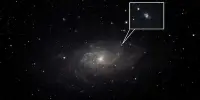The Gaia Space Observatory has revealed the motion of millions of stars in incredible detail, allowing astronomers to see patterns and discover shared origins and histories. This has spawned the field of galactic archaeology, which has uncovered the identities of smaller galaxies absorbed so deeply into the Milky Way that their identities were previously unknown. Dr. Chervin Laporte of the University of Barcelona has utilized Gaia’s measurements to investigate an often-overlooked section of the galaxy: the region to the left of the galactic center as seen from Earth.
Laporte and co-authors describe formations in Monthly Notices of the Royal Astronomical Society: Letters that they believe we’re part of the Milky Way from the beginning but have twisted so much by other effects that they cannot recognize. The location they researched is known as the galactic anti-center, and it is located on the constellation Auriga. The authors discovered a number of filaments that had never been seen before, as well as bringing several previously known structures into better focus.

With so many structures seen, Laporte and his co-authors believe the same thing does not cause them all. Some are presumably the remnants of old spiral arms that have been disrupted by external causes, while others might represent the crests of waves generated by forces within the galaxy. To distinguish between the two explanations, the team has reserved telescope time to analyze each structure in more detail. “Typically, because to the intervening dust that significantly obscures much of the Galactic midplane, this area of the Milky Way has remained poorly investigated,” Laporte said in a statement.
Even before Gaia, astronomers discovered the Sagittarius dwarf galaxy (SDG), which demonstrated that the Milky Way is not exactly the calm paradise we originally assumed. The SDG is concentrated enough that its gravity can disturb stars in neighboring areas of our galaxy’s outer rim while having just one three-thousandth of the Milky Way’s mass. Laporte previously analyzed how the velocity of the galactic field might cause corrugations in the galactic disk in a galaxy like the SDG. Several more tiny galaxies have been spotted since then, first considered to be circling the Milky Way but now identified as newcomers. Some of them are close enough together and thick enough to have significant effects on their own.
The anti center stream is one of the formations discovered before this research. Its stars are generally roughly 8 billion years old, implying that the stream is a remnant of a galaxy that was absorbed into the Milky Way long ago, rather than an alien galaxy.
Laporte and his co-authors in recent research discovered a spiral structure suggesting a disruption in the galactic disk from an encounter with an unknown dwarf galaxy a few hundred million years ago. “We were ecstatic to learn that the Gaia movements’ data assisted us in discovering these filamentary formations!” According to Laporte, “Now the task is to find out exactly what these entities are, how they came to be, why they are so numerous, and what they may tell us about the Milky Way, its genesis, and development.”















